Polypropylene, the material now recommended for COVID-19 mask filters: What it is, where to get it
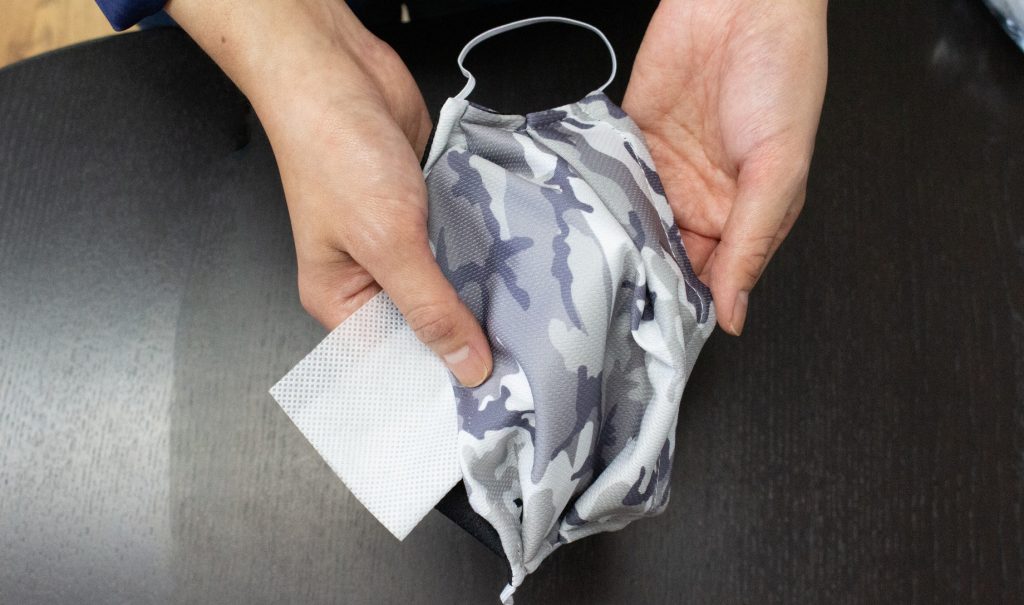
New recommendation advise using an additional layer of polypropylene fabric in cloth masks to act as a filter. (Sara Alas/Niko Apparel)
BY Catherine Clase, Charles-Francois de Lannoy and Scott Laengert
November 20, 2020
Adding a third layer to cloth face masks is now recommended for preventing the spread of COVID-19. Non-woven polypropylene fabric is the material of choice for this third layer, but many people may not know what this material is, or where to get it.
With masks being made at home and by local clothing companies, here’s what you need to know about Public Health Agency of Canada’s new recommendations.
Every study that has examined layering has found that using additional layers in face masks improves filtration, but some fabrics provide more filtration than others. We support the public health recommendation, and specifically recommend the use of industry-grade “spunbond” polypropylene as a middle layer in washable cloth masks.
Spunbond polypropylene destined for the clothing and furniture industries has a fabric-like feel. It is washable and will not divert supply of medical-grade polypropylene from the manufacture of formal personal protective equipment.
Our research group, with expertise in epidemiology, chemistry, textiles and the mask industry, seeks to improve cloth masks for community use.
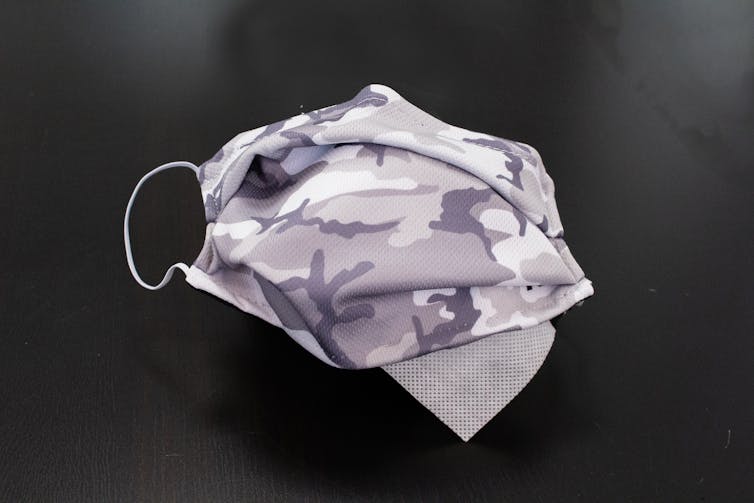
Types of non-woven polypropylene
Traditional materials for clothing and furniture have a woven or knitted structure. Non-woven materials, by contrast, have a random arrangement of fibres, like spaghetti on a plate. This randomness enables high particle filtration while remaining highly breathable.
There are many types of non-woven polypropylene. The most common are spunbond, meltblown and spunlace materials.
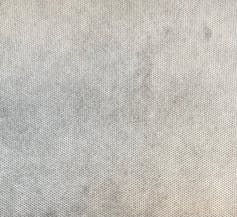
In some spunbond polypropylene the randomly oriented fibres are compressed and melted together in a pattern of small, closely spaced welds, called point bonds.
Lightweight medical-grade spunbond polypropylene, found in the outer layers of three-layer certified medical masks, has been tailored for medical uses. But as a single-use material, it is not designed to be washed.
Washable spunbond polypropylene is used in the clothing and furniture industry. It is one of several materials used as interfacing, to give structure to waistbands and collars, and around zippers. It is also used to seal the bottom of couches and chairs. It is readily available from fabric distributors and is not currently in short supply since it is not part of the supply chain for personal protective equipment. This material likely aligns with public health recommendations.
Industry-grade spunbond polypropylene has a fabric-like feel and cuts without fraying.
Covid-19 masks FAQ: What you can use, how it works and more
Recommended material
For community mask manufacture, we suggest using industry-grade spunbond polypropylene.
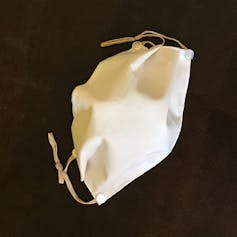
Manufacturers produce single and double layers of spunbond. There are few published data on its filtration properties, but we suggest using a fabric with a rating of 68 grams per square metre, or two layers of a less dense one.
The material can be integrated as a middle layer when masks are being made.
Alternatively, a rectangle of spunbond polypropylene can be inserted between the two outer layers of a cloth mask. The material does not fray easily. If using two layers of polypropylene, we suggest folding the material in half and sewing it together with a simple stitch or an overlock, to make a washable filter.
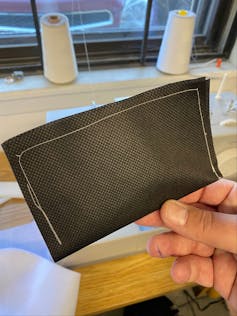
The polypropylene can be cleaned as recommended by Health Canada: a hot wash with detergent. It can be washed with the mask or separately. It should not be tumble dried: it should be removed from the mask and hung or laid flat to dry before reinserting. Do not iron it: it is plastic and will melt.
Our website and previous research summarize what is known about choosing suitable material for the other layers.
Fabric distributors have these materials in bulk and are working to get them to retail. Mask makers can expect to see them in stores by late November.
Unsuitable materials
It is important to recognize that not all interfacing is polypropylene. Many brands are polyester or polyester-rayon blends. This is a completely different material. In the retail market, interfacing is sometimes sold as a fusible product. This means that it is pre-glued to help with accurate placement before it is stitched into place. These pre-glued fabrics should not be used for face coverings because the glue may affect filtration and breathability.
Some reusable shopping bags made from spunbond have a shiny plastic coating. These are not breathable and should not be used.
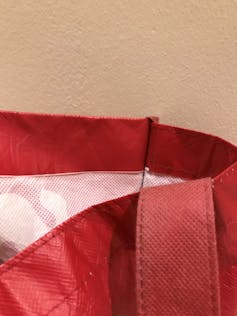
Meltblown polypropylene is used as the middle layer of many certified medical masks and in the manufacture of respirators such as N95s: it filters very well. It remains in short supply, with many distributors in Canada fully committed to July 2021. It is not intended to be washed, though novel programs for limited reuse of respirators have been developed for hospitals.
Because of the supply issue and because it is not washable, we do not recommend using meltblown polypropylene for reusable non-medical masks.
Disposable non-medical filters intended to be inserted into pocket masks are sold commercially and may contain meltblown, spunbond and other components; it is not always possible to determine their composition from the packaging or advertisements. Currently no standards define their use in Canada. They are designed to be discarded after each use.
Spunlace polypropylene tends to be naturally springy and in contrast to spunbond and meltblown, it absorbs liquids. Some wet wipes are produced by spunlace methods. However, the material used is often not polypropylene but rather viscose-polyester blend, to increase absorbency. The composition of the wet ingredients is clearly specified on packaging, but many wipes do not include the fibre composition of the material. These materials are not intended to be laundered and reused. Some wipes contain active ingredients that might be harmful if inhaled. For all these reasons, we do not recommend using dried-out wipes as filters.
Non-woven polypropylene made with a needle-punch method is a continuous material that is completely perforated by thousands of fine needles on a roller. These holes offer a low-resistance path for airflow without fibres projecting into the gap. We predict they would filter poorly and do not recommend them.
Imperfect does not mean unhelpful
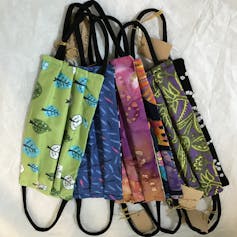
Imperfect use of imperfect masks has the potential to help control the spread of COVID-19. Important decreases in transmission have been observed following mask mandates, using the masks currently available. Industry is working to respond to the new guidelines by increasing the availability of polypropylene fabrics.
At the Centre of Excellence in Protective Equipment and Materials, engineering faculty and graduate students are working to identify the best materials to use for cloth masks. We hope to be able to describe textiles that are likely to filter well and be breathable using standard industry descriptors such as the type of material and the weight.
Barry Diamond, managing director of Veratex Lining Ltd., co-authored this article. He is a member of the Cloth Mask Knowledge Exchange.![]()
Catherine Clase is a physician, epidemiologist and associate professor; Charles-Francois de Lannoy is an assistant professor of chemical engineering; and Scott Laengert is a PhD student in chemical engineering. This article is republished from The Conversation under a Creative Commons license. Read the original article.
This research, and research like it, is part of Canada’s Global Nexus for Pandemics and Biological Threats, an international network launched at McMaster with scientists, clinical health and medical specialists, engineers, social scientists and other experts working collaboratively to prevent future pandemics and mitigate global health threats.


